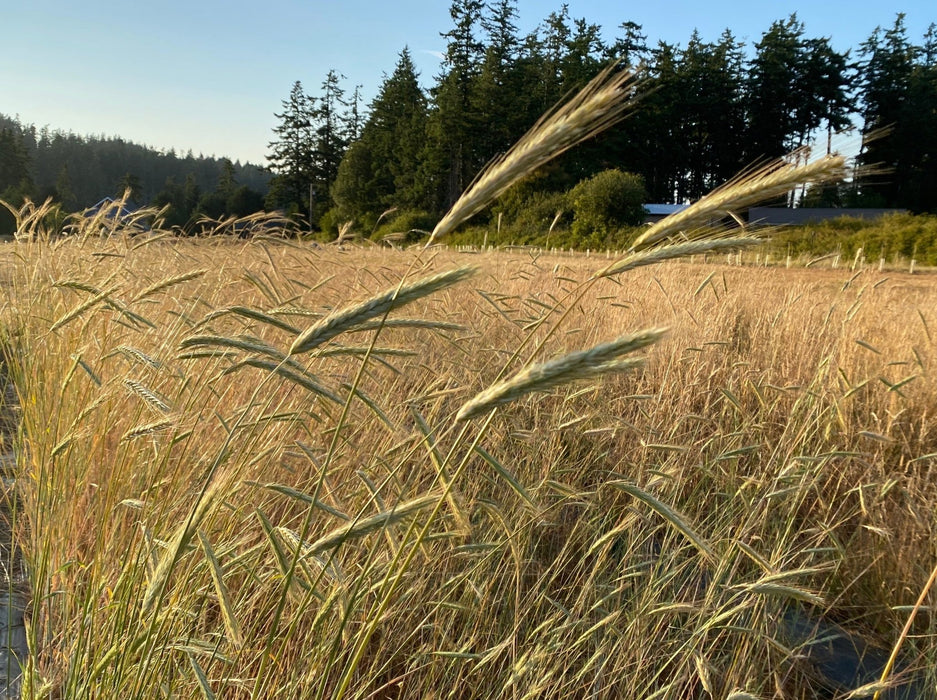
Perennial Forest Rye / Waldstaudenroggen (Secale multicaule)
Where to begin with this extraordinary plant…
This is likely one of the oldest cultivated rye varieties in the world. It is a semi-wild plant, a multi-use species that can be planted for bread flour, livestock fodder, and wildlife cover. It can also incorporate into diverse wildflower meadows without becoming weedy or invasive – and possibly has some very useful properties for habitat restoration (read on for more about that).
Originating in far northern Europe and Eurasia (Finland, Siberia, Poland, Germany, and the Baltic lands), Waldstaudenroggen rye was planted by hand-scattering the seed into newly burned forest clearings where it could grow up as a tall understory grain crop amid burned trees and stumps.
With rapid vigor and a high tolerance for poor soils, it is an adaptable and forgiving crop that puts on tremendous biomass. We’ve grown this in pure marine deposit clay on our farm, just feet above sea level, with drought and salt water infiltration, and it still grows to a handsome 5-feet in height.
While the actual grain yields are lower than modern rye varieties (and the grain itself is a bit smaller), the plant’s extended lifecycle makes it a unique and valuable crop. Rather than harvesting the grain in the first year, it can be mowed, grazed, or cut for hay before flowering, then it will develop a grain crop in the second full growing season.
Despite the common name (not bestowed by us!), the actual lifecycle of “perennial forest rye” isn’t an indefinitely long-lived perennial in our experience. Rather the lifecycle can extended by cutting or grazing to delay grain production (after which many of the plants will start to decline). In fact, cutting or grazing the plant encourages new shoot development and a thicker stand of rye stems. Moreover, it does reseed itself in fields with minimal thatch -- further extending its presence on the landscape.
In eastern Europe this is considered an exceptional hay plant for cattle, and is sown as a wildlife food plot by deer hunters. Farmers also hand-harvest the seeds, then sprout them as a quality chicken feed to increase the nutritional content of eggs. The flour of Waldstaudenroggen can be baked into Nordic-style breads such as rugbrød (and there is significant research, particularly from Poland, on the nutritional content of this grain compared to other rye varieties). Although it is an introduced species, we also think it has structural and biological value for creating novel “forager meadows” or wild gardens, where, incorporated with native plants, it can support humans and wildlife alike.
Finally, because this plant continues to grow for several years with repeat cutting, it might serve as a very useful tool for habitat restoration or for the preparation of new ground for other crops. For example, newly cultivated ground with a lot of weed seed in soil, could be planted with this crop, then the rye can be repeatedly mowed for a year or two -- allowing for the weed seeds to germinate (then die from mowing) while the rye simply becomes thicker. Once the weed pressure is diminished, the rye can be allowed to head out and produce a grain crop, leaving clean ground behind for replanting with other species.
This is a beautiful plant, with long, slender, awned seed heads. In most climates this can be fall-sown resulting in a grain crop the following summer (if the stand is not cut or grazed), or planted in spring for purely vegetative growth the first year, and a grain crop in year two (unless cut or grazed during the growth period).
Packet Size: 50 grams (approximately 2000-3000 seeds). We hope to make larger quantities available in the future as we scale up production.
